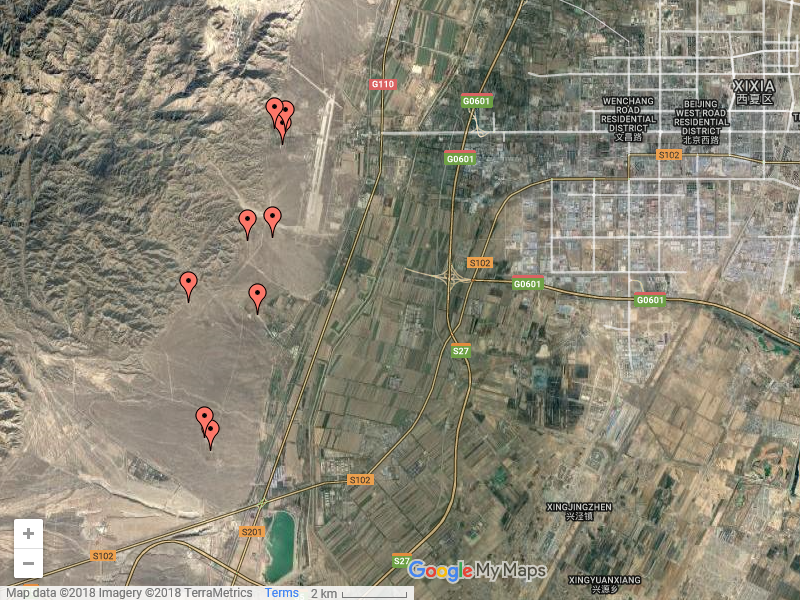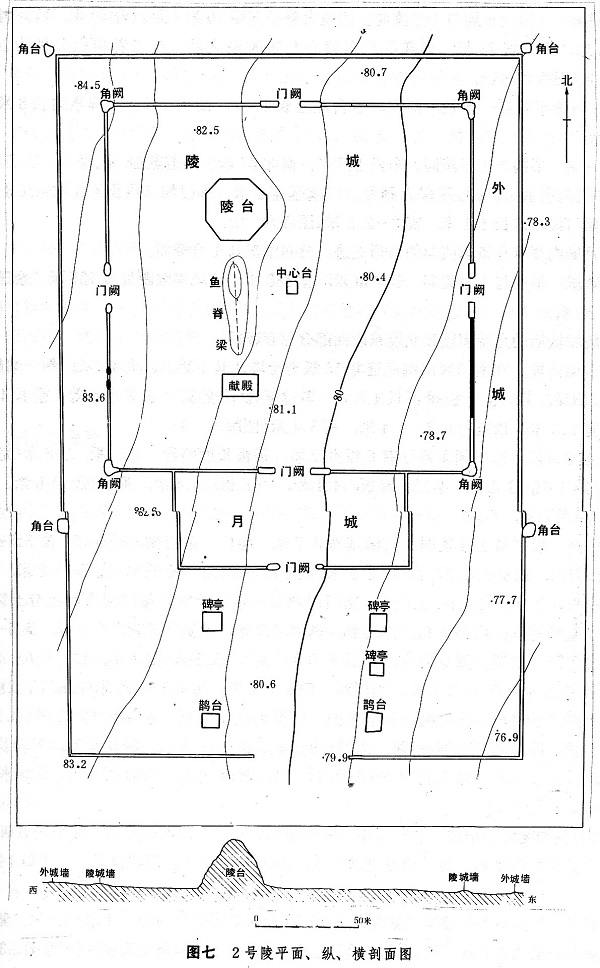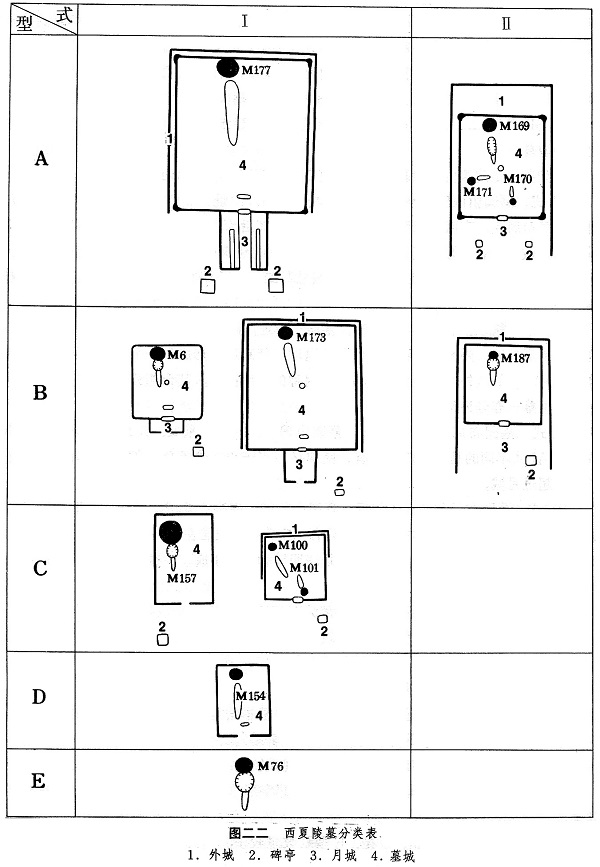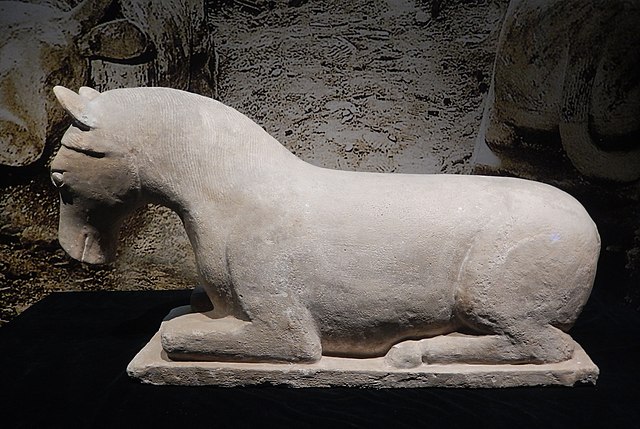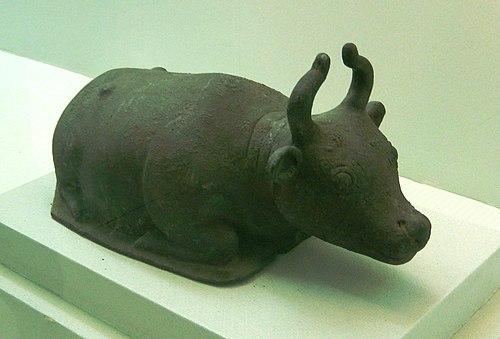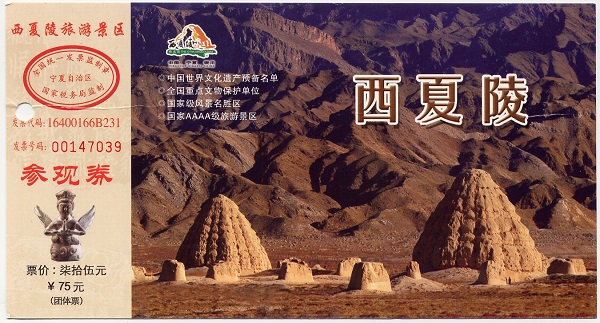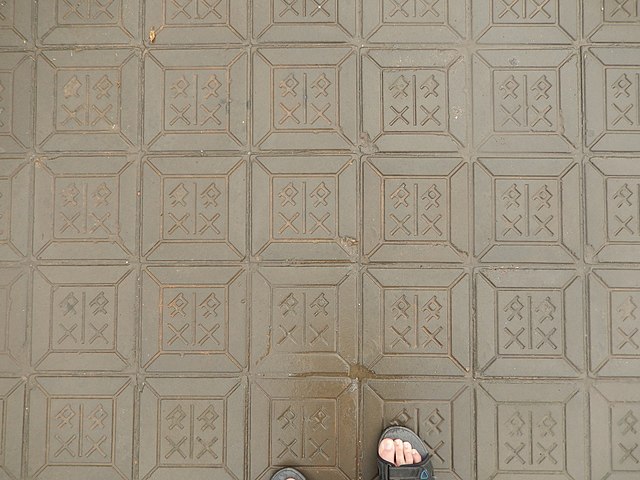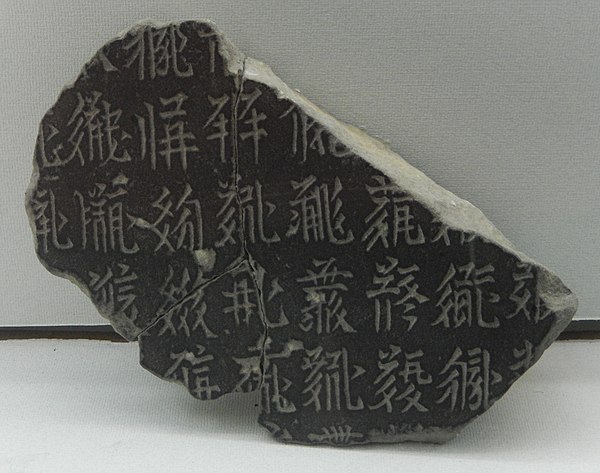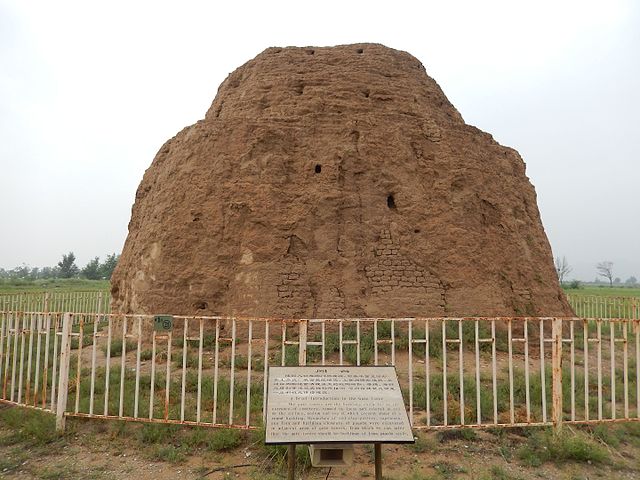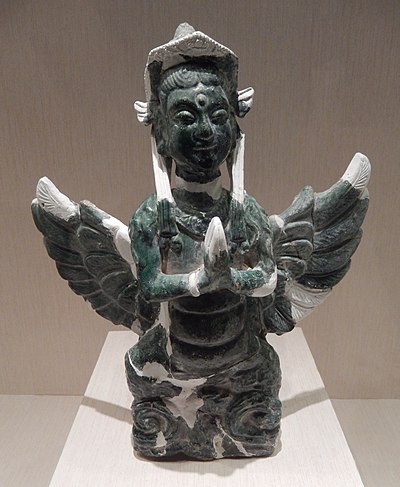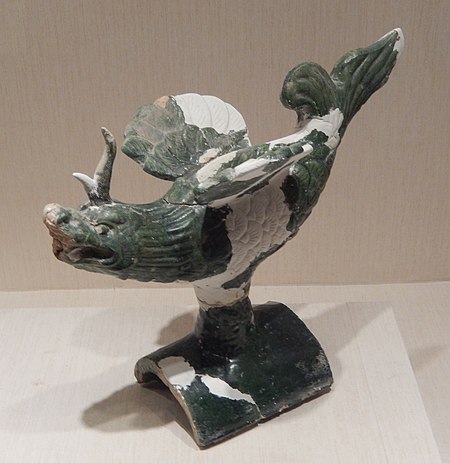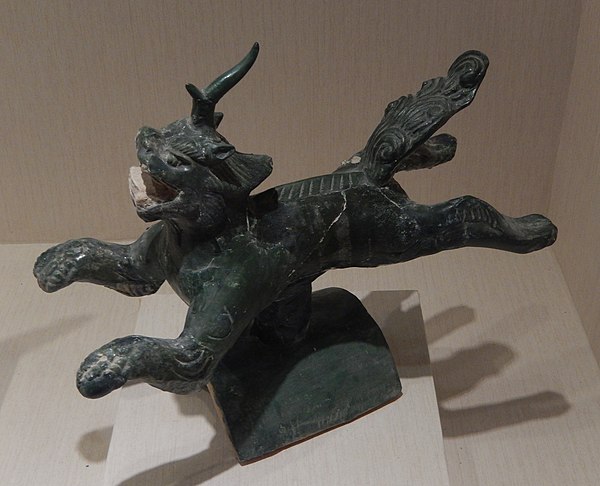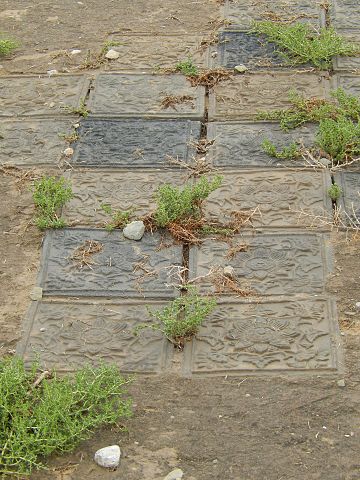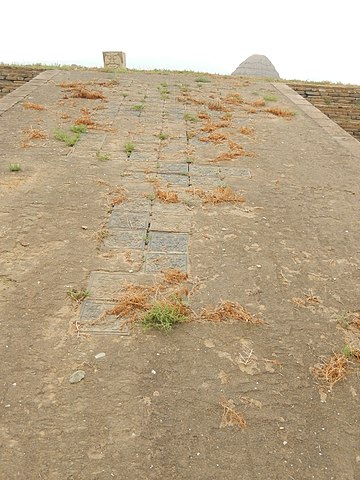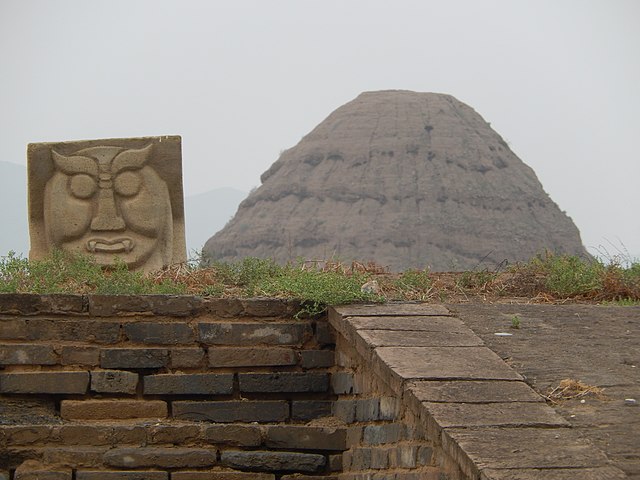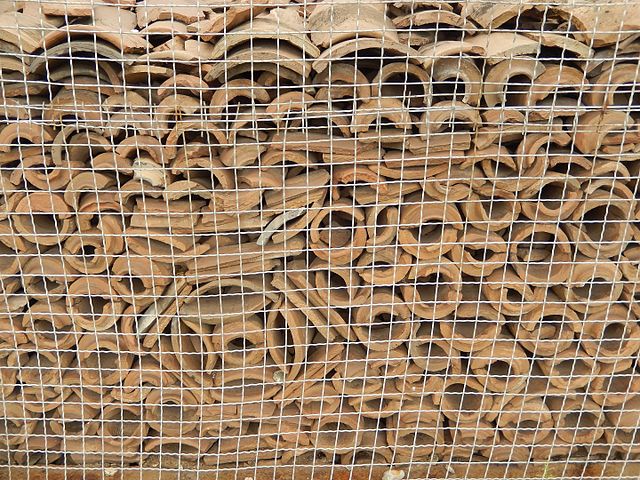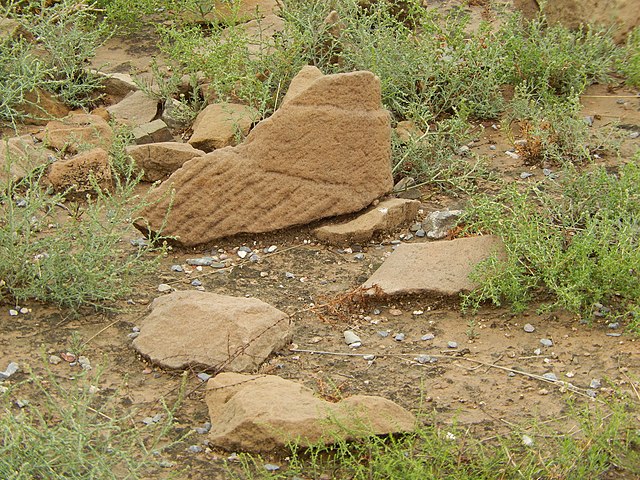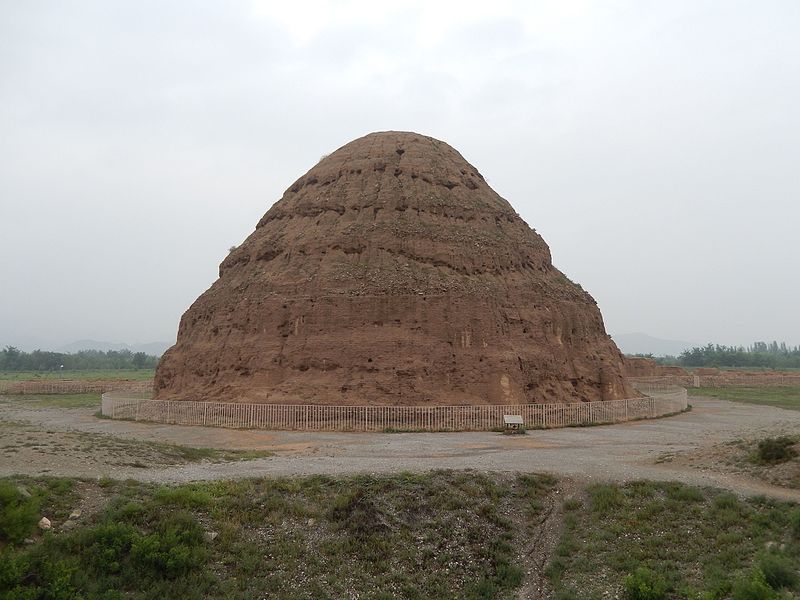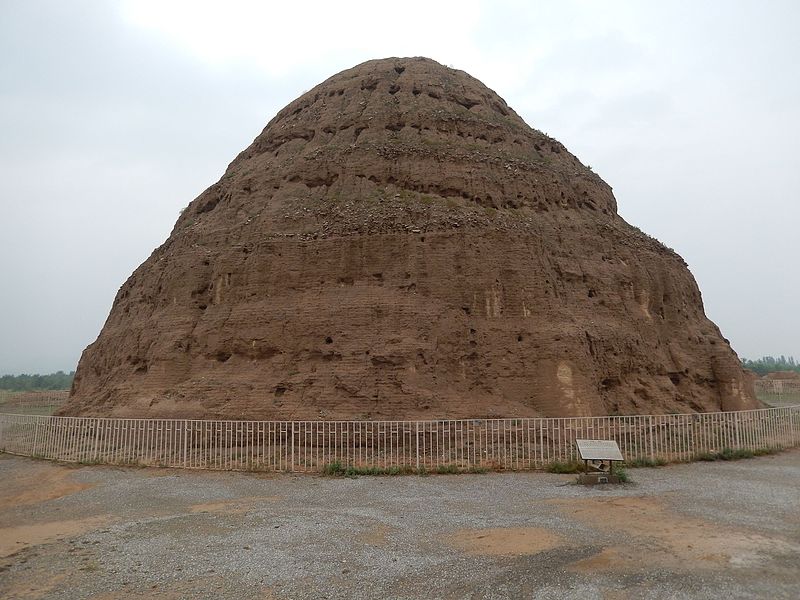Diary of a Rambling Antiquarian
Monday, 22 August 2016
Western Xia Tombs
On Friday we visited the 108 Stupas 20 km south of Yinchuan, and over the weekend I attended (but did not actively participate in) a Tangut studies conference held at the Research Center for Tangut History and Culture of Beifang University of Nationalities 北方民族大学西夏研究所. Today is my last day in Yinchuan, and an excursion to the Western Xia imperial mausoleums has been arranged. There are over two hundred Western Xia tombs of various sizes located on the plain between the Helan mountains to the west and the city of Yinchuan (the erstwhile capital of the Western Xia empire) to the east. The nine biggest tombs have been identified as the final resting places of the emperors of the Western Xia, with their consorts and family members buried in smaller tombs nearby.
Location of Nine Western Xia Imperial Tombs
{Map data ©2018 Imagery ©2018 TerraMetrics}
Click on the image to open my Google Maps map showing the location of all 200+ Western Xia tombs Yinchuan.
(Image of map showing all Western Xia tombs)
Background Discussion of the Western Xia Tombs
The nine imperial tombs are designated "L1" through "L9" from south to north, as shown on the plan below ("L" stands for Líng 陵 "mausoleum"), and the minor tombs are designated "M1" through "M207" ("M" stands for Mù 墓 "tomb").
Plan of Nine Western Xia Imperial Tombs
Source: Xǔ Chéng and Dù Yùbīng, Xīxià Líng Fig. 1 on p. 7
For ease of discussion, the table below lists the Western Xia emperors, including the father and grandfather of the first emperor, who were posthumously given imperial titles.
| No. | Personal Name | Imperial Name | Posthumous Title | Tomb Name | Dates | Reign |
|---|---|---|---|---|---|---|
| Lǐ Jìqiān 李繼遷 |
Tàizǔ 太祖 |
Shénwǔ Huángdì 神武皇帝 |
Yùlíng 裕陵 |
963–1004 | (990–1004) | |
| Lǐ Démíng 李德明 |
Tàizōng 太宗 |
Guāngshèng Huángdì 光聖皇帝 |
Jiālíng 嘉陵 |
981–1032 | (1004–1032) | |
| 1 | Lǐ Yuánhào 李元昊 |
Jǐngzōng 景宗 |
Wǔliè Huángdì 武烈皇帝 |
Tàilíng 泰陵 |
1003–1048 | 1038–1048 |
| 2 | Lǐ Liàngzuò 李諒祚 |
Yìzōng 毅宗 |
Zhāoyīng Huángdì 昭英皇帝 |
Ānlíng 安陵 |
1047–1068 | 1048–1068 |
| 3 | Lǐ Bǐngcháng 李秉常 |
Huìzōng 惠宗 |
Kāngjìng Huángdì 康靖皇帝 |
Xiànlíng 獻陵 |
1061–1086 | 1068–1086 |
| 4 | Lǐ Qiánshùn 李乾順 |
Chóngzōng 崇宗 |
Shèngwén Huángdì 聖文皇帝 |
Xiǎnlíng 顯陵 |
1083–1139 | 1086–1139 |
| 5 | Lǐ Rénxiào 李仁孝 |
Rénzōng 仁宗 |
Shèngzhēn Huángdì 聖德皇帝 |
Shòulíng 壽陵 |
1124–1193 | 1139–1193 |
| 6 | Lǐ Chúnyòu 李純佑 |
Huánzōng 桓宗 |
Zhāojiǎn Huángdì 昭簡皇帝 |
Zhuānglíng 莊陵 |
1177–1206 | 1193–1206 |
| 7 | Lǐ Ānquán 李安全 |
Xiāngzōng 襄宗 |
Jìngmù Huángdì 敬慕皇帝 |
Kānglíng 康陵 |
1170–1211 | 1206–1211 |
| 8 | Lǐ Zūnxū 李遵頊 |
Shénzōng 神宗 |
Yīngwén Huángdì 英文皇帝 |
1163–1226 | 1211–1223 | |
| 9 | Lǐ Déwàng 李德旺 |
Xiànzōng 獻宗 |
Xiào'āi 孝哀 |
1181–1226 | 1223–1226 | |
| 10 | Lǐ Xiàn 李晛 |
(Mòdì 末帝 "Last Emperor") |
* | ?–1227 | 1226–1227 |
* Lǐ Xiàn was posthumously titled Shidurghu ᠱᠢᠳᠤᠷᠭᠤ "simple, right, just" by the Mongols, and is referred to as Schidascou or Shidaskû in 18th-century European sources.
The imperial tombs were originally identifiable by steles with inscriptions in Chinese and Tangut erected to commemorate and eulogize the occupants of the tombs, but when the Western Xia was defeated by the Mongols in 1227 they burned the imperial tombs and smashed to pieces all the steles, so it is difficult to be sure who the tombs were built for. The imperial tombs each have the remains of two or three stele pavilions (only L1, L2 and L5 have three), which were built to house steles with Tangut or Chinese inscriptions, and about 60–70 of the minor tombs also have the remains of stele pavilions. Ten stele pavilions from four imperial tombs (L3, L5, L6, L7) and two minor tombs (M177, M182) were excavated during the 1970s and 1980s, resulting in the recovery of several thousand fragments of steles, some blank, some with decoration, and some with Chinese or Tangut text. The fragments with writing excavated from tombs L6, L7, M177 and M182 were published in Lǐ 1984. Some of the inscribed fragments from tombs L3 and L5 were published in Xǔ and Dù 1995. The second stele pavilion at L3 was excavated in 1998, resulting in the discovery of a further 711. Additionally, 111 Tangut and Chinese fragments have been found at various other locations at the Western Xia tombs site between 1971 and 2005, and 197 Tangut fragments are in the private collection of Jiǎ Jìngyán 賈敬顏.
| Tomb | Pavilion | Date Excavated | Fragments | Language |
|---|---|---|---|---|
| L3 | East | 1987 | 360 fragments | Tangut |
| L3 | West | 1998 | 711 fragments | Tangut |
| L5 | East (north) | 1977 | 26 fragments | Chinese |
| L5 | West | 1977 | 63 fragments | Tangut |
| L6 | East | 1974 | 338 fragments (48 large characters; 290 small characters) | Tangut |
| L6 | West | 1974 | 709 fragments | Tangut (388) Chinese (321) |
| L7 | East | 1975 | 510 fragments | Chinese |
| L7 | West | 1975 | 1,284 fragments (including 19 fragments of seal script stele heading) | Tangut |
| L8 | West | 1972 | 49 fragments | Tangut (47) Chinese (2) |
| M161 | West | 1972 | 18 fragments | Chinese |
| M177 | East | 1977 | 81 fragments | Tangut (55) Chinese (26) |
| M177 | West | 1977 | 35 fragments | Tangut (20) Chinese (15) |
| M182 | 1975 | 361 fragments | Tangut (133) Chinese (228) |
|
| Elsewhere | 1971–2005 | 111 fragments | Tangut (29) Chinese (82) |
|
| Jiǎ Jìngyán | 197 fragments | Tangut |
Based on these stele fragments, Lǐ Fànwén 1984 was able to identify the occupants of tombs L6, L7, M177 and M182, although two of his identifications have not been widely accepted.
- Lǐ tentatively identified the occupant of L6 (old number M8) as Emperor Shenzong, but this identification has since been rejected.
- Lǐ identified the occupant of L7 (old number M2) as Lǐ Rénxiào (Emperor Renzong), and this identification is now accepted as certain.
- Lǐ identified the occupant of M177 (old number M101) as Lǐ Rénxiào's younger brother Lǐ Rényǒu 李仁友 (c. 1126–1196). Xǔ and Dù do not support this identification, and suggest the occupant was born circa 1150 and died circa 1220 (the occupant's skeleton is dated to about seventy years old).
- Lǐ identified the occupant of M182 (old number M108) as Wéimíng Ānhuì 嵬名安惠, chief minister of Lǐ Qiánshùn, who enfeoffed him as Prince Zhengxian of Liang (梁國正獻王). He died in 1129, but the stele fragments record the date 1215, so the steles cannot have been written until some 86 years after his death. Lǐ Fànwén's explanation (which Xǔ and Dù agree with) is that Wéimíng's family lost favour after his death, and it was only when the family were rehabilitated after Lǐ Zūnxū acceded to the throne that it was possible to erect steles in his memory.
As there were ten emperors of the Western Xia, and there would be no tomb for the last emperor who was killed by the Mongols, Lǐ Fànwén postulated that the nine large-scale tombs are for the first nine emperors, from Emperor Jingzong (Lǐ Yuánhào) through Emperor Xianzong (Lǐ Déwàng). To fit with his identification of Tombs L6 and L7 as belonging to the eighth and fifth emperors respectively, he hypothesized that the tombs for the first six emperors were built from south to north away from the edge of the Helan Mountains (i.e. L1, L2, L3, L5, L7, L8 for Emperors Jingzong through Huanzong), and the tombs for the last three emperors were built from south to north along the edge of the Helan Mountains (i.e. L4, L6, L9 for Emperors Xiangzong through Xianzong).
However, this hypothesis has not gained acceptance, for two main reasons. Firstly, Lǐ Yuánhào made his father and grandfather posthumous emperors, and it is recorded that they were buried by the Helan Mountains. The two southernmost tombs (L1 and L2) are in the position of greatest respect, and are the only two tombs to have a tomb platform of nine steps (the other tombs only have seven or five steps), so according to Dù Yùbīng they should be the tombs of Lǐ Yuánhào's father and grandfather. Secondly, there would not have been enough time to build a tomb for Emperor Xianzong before the Western Xia was overthrown in the year following his death, and during this period of war there may also not have been enough time to build a tomb for Emperor Shenzong. Therefore, the currently accepted hypothesis is that the nine large-scale tombs were built for the grandfather and father of Lǐ Yuánhào (L1 and L2 respectively), and for the first seven emperors (L3 through L9), with the tombs zigzagging up the plain from south to north.
| No. | Old No. | Occupant | Role | Death | Tomb Plan * |
|---|---|---|---|---|---|
| L1 | M15 | Lǐ Jìqiān 李繼遷 |
Grandfather of 1st emperor | 1004 | Fig. 6 |
| L2 | M14 | Lǐ Démíng 李德明 |
Father of 1st emperor | 1032 | Fig. 7 |
| L3 | M11 | Lǐ Yuánhào 李元昊 |
1st emperor | 1048 | Fig. 8 |
| L4 | M12 | Lǐ Liàngzuò 李諒祚 |
2nd emperor | 1067 | Fig. 10 |
| L5 | M10 | Lǐ Bǐngcháng 李秉常 |
3rd emperor | 1086 | Fig. 12 |
| L6 | M8 | Lǐ Qiánshùn 李乾順 |
4th emperor | 1139 | Fig. 13 |
| L7 | M2 | Lǐ Rénxiào 李仁孝 |
5th emperor | 1193 | Fig. 21 |
| L8 | Lǐ Chúnyòu 李純佑 |
6th emperor | 1206 | ||
| L9 | M1 | Lǐ Ānquán 李安全 |
7th emperor | 1211 |
* Tombs L8 and L9 were built over during the 1970s, destroying all of the tomb sites except for the two burial mounds. Tomb L7 has been partially built on, but most of the site is intact.
The imperial mausoleums all share the same basic plan, oriented south to north, as illustrated for Tomb L2 shown below. They have the following features:
- Outer Wall (wàichéng 外城). L1, L2, L5, L6 and L7 have an outer wall that encloses all or most of the tomb, with corner towers (jiǎotái 角臺). Tombs L3 and L4 are unexpectedly missing an outer wall.
- Gate Tower, literally "magpie terrace" (quètái 鵲臺). The entrance to the tomb complex is from the south, and all tombs have a pair of towers, up to 6 m in height, made of rammed earth just inside the south outer wall, flanking the "spirit road" leading up to the tomb. These towers are called "magpie terraces" because of an anecdote that in 773 a pair of magpies was seen to be repairing the observatory platform at the Qianling Mausoleum where Emperor Gaozong and Empress Wu Zetian of the Tang dynasty were buried. In fact they might not be gate towers at all, but the remnant cores of Buddhist stupas.
- Stele Pavilion (bēitíng 碑亭). All tombs have at least one stele pavilion, which is a raised platform of rammed earth on which steles with epitaphs for the dead were placed (whether not the steles were inside a pavilion built on the platform is debatable). Tombs L3, L6 and L7 have two stele pavilions, one on each side of the spirit road, directly between the gate towers to the south and the outer enclosure to the north. Tombs L1, L2 and L5 have an additional smaller stele pavilion on the east side, between the main stele pavilion and the gate tower. Tomb L4 only seems to have a single stele pavilion, on the west side.
- Outer Enclosure, literally "moon walled city" (yuèchéng 月城). A protective wall or barbican encloses a rectangular area in front of the entrance to the inner enclosure.
- Inner Enclosure, literally "mausoleum walled city" (língchéng 陵城). A square wall encloses the main tomb area, with watch-towers (jiǎoquè 角闕) at the four corners, and fortified entrances in the middle of the wall on all four sides.
- Tomb Mound (língtái 陵臺). The main feature of the whole tomb is a huge mound, up to 30 m across and 23 m in height, positioned off-centre in the north-west part of the inner enclosure. The mounds are constructed from rammed earth, and are octagonal in shape (L5 has been eroded to circular rump), with five or seven levels. The mounds have holes for wooden beams, and vast numbers of tiles have been recovered from the vicinity, which indicates that the surviving mounds are only the cores of a more substantial architectural feature. They would originally have been coated with bricks, and have tiled eaves at each level, forming an impressive building somewhat similar to a wide-based pagoda. Although it now looks like a burial mound, and is called a burial mound, this structure is solid, and does not actually house the burial chamber, which is deep underground. This pagoda-style 'burial mound' is unique to the Tanguts, and is completely different to other imperial mausoleums in China.
- Hall of Offerings (xiàndiàn 献殿). The hall is situated in the south-west part of the inner enclosure, about 50 m directly south of the tomb mound. All that remains of the hall is a square platform of rammed earth.
- Fish-back Ridge (yújǐliáng 魚脊梁). Running south to north between the hall of offerings and the tomb mound is a low ridge, up to 50 m in length, with its highest and widest point (c. 12 m wide and 2 m high) at the north, tapering narrower and lower towards the south. The ridge covers the sloping passageway (mùdào 墓道) from the surface to the burial chamber (mùshì 墓室) deep beneath the earth. For Tomb L3 the stepped passageway is 46 metres in length and slopes at 24°.
- Central Platform (zhōngxīntái 中心臺). In the exact centre of the inner enclosure of Tombs L1 and L2 (and also some minor tombs) there is a square platform of rammed earth, about 5 m × 5 m, and 5 m in height, with broken tile fragments scattered around. The purpose of this structure is unknown.
- Robber Tunnel (dàokēng 盗坑). Obvously not part of the original tomb layout, but unfortunately a ubiquitous feature of the Western Xia tombs is a pit situated between the north end of the fish-back ridge and the tomb mound, which is the remains of a robber tunnel dug by grave robbers in centuries past, directly above the entrance to the burial chamber.
Plan of Tomb L2
Source: Xǔ Chéng and Dù Yùbīng, Xīxià Líng Fig. 7 on p. 17
The minor tombs copy this general layout, but on a smaller scale. Most have a square or rectangular wall forming an inner enclosure, in northwest part of which the tomb mound and a fish-back ridge are sited. Some enclosures have two or three tomb mounds, presumably representing a family group. Some of the large tombs have an outer enclosure, and one or tw stele pavilions. A minority of tombs have no enclosure at all. The following six types of minor tomb layout have been identified:
Classification of tomb types
Source: Xǔ Chéng and Dù Yùbīng, Xīxià Líng Fig. 22 on p. 40
Tombs M177 (Type AI) and M182 (Type C) were excavated in the 1970s, and the diagram below shows the location of the burial chamber below the burial mound, and the sloping passageway that leads from the surface to the entrance to the burial chamber.
Photograph of Tomb M177 showing the excavated tomb passageway
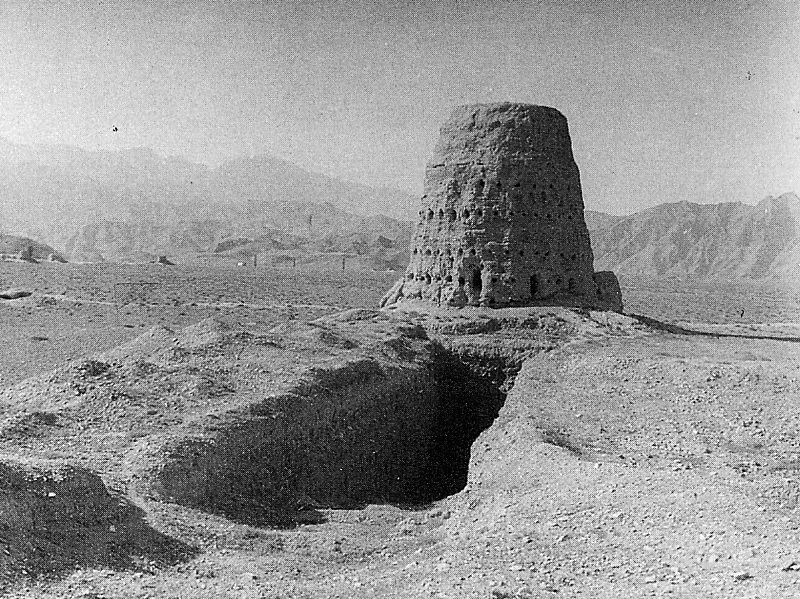
Source: Xǔ Chéng and Dù Yùbīng, Xīxià Líng Plate IV.3
Cross-sectional view of Tomb M177
Source: Xǔ Chéng and Dù Yùbīng, Xīxià Líng Fig. 42 on p. 74
(Cross-sectional view of Tomb M182)
Stone horse excavated from Tomb M177
Note on my Map of the Western Xia Tombs
My Google map of the Western Xia tombs is based on the maps and descriptions of the tombs given in the 1995 book by Xǔ Chéng and Dù Yùbīng (Xīxià Líng 西夏陵). The books divides the minor tombs into four geographical groups, based on their proximity to imperial tombs (there are no tombs in the vicinity of L4):
- Group I: M1–M32, and M194–M195 (34 tombs). Situated to the east and west of L1 and L2.
- Group II: M33–M77, M196–M202, and M207 (53 tombs). Situated south and west of L3.
- Group III: M78–M178 (101 tombs). Situated south and south-east of L5 and L6.
- Group IV: M179–M193, and M203–M206 (19 tombs). Situated south and south-east of L7 through L9, except for M193 which is an outlier, some way north of L8.
The maps in the book show the location of tombs M1 through M70, M72 through M77, M81 through M177, and M179 through M206. M71 is not shown on any map, but is described as being 128 m west of L3, so I have placed a marker for it between M73 and M74. M178 is not shown on any map, and is not described in the text of the book, so I have no idea where it is. Two tombs are labelled M200 in Fig. 26, but I am confident that the one at the top right is actually M207. M78 through M80 are not shown on any map, and it is explained on p. 53 that these three tombs formed a cluster located in a small coll called "Four Tombs" (四座坟), situated about 1 km south of L6, and that two of the three have been destroyed. M78 (which may or may not be the surviving tomb) was excavated between 1972 and 1975. I am unsure of the precise location of M78 through M80, but have put a marker for them about 1 km south-west of L6, on the edge of the mountains.
On my map the nine imperial tombs are marked with red labels. Minor tombs that are visible in the satellite images are marked with blue labels, but where I cannot recognize a tomb with certainty, I mark its approximate position with a light blue label. Multiple tombs in a single tomb enclosure are marked by a single label. In total the positions of 206 minor tombs are labelled on the map.
Bronze ox excavated from Tomb M78
A similar bronze ox, excavated from Tomb M177, is on display at the Ningxia Museum.
Back to Today's Visit
It poured with rain all last night, and it is still lightly raining as we gather for the minibus outside our hotel. Our hotel is in the Xixia District in the west of Yinchuan, so it is less than 10 km to the tombs, but it still takes half an hour to get there. Like most Chinese tourist attractions, we are met by a vast expanse of concrete paving stones, and rows of tourist shops either side of the entrance to the "Western Xia Tombs Tourist Scenic Area".
Entrance ticket for the Western Xia Tombs Tourist Scenic Area
Balancing in the space in front of the entrance gate is a gigantic reproduction of a stele fragment with Tangut writing inscribed on it. A rather poor calligraphic copy of the original Tangut text in my opinion, but I reluctantly (and with a rather too obvious look of disdain on my face) allow myself to be photographed standing next to it.
Giant Reproduction of a Stele Fragment

(See below for the actual piece on display in the museum)
When we got through the entrance our first stop was the Xixia Museum (Xīxià Bówùguǎn 西夏博物馆)on the right. The area in front of the museum is paved with floor tiles inscribed with the Tangut character 𗾟 meaning 'vast' or 'broad', probably intended to correspond to the Chinese character bó 博 in the word 'museum'.
Tangut floor tiles
The museum houses many Western Xia artefacts and Tangut-inscribed objects, and I spent a good hour looking around the museum. Among the objects on display I found the actual stele fragment I had been standing next to half an hour ago.
Stele fragment with Tangut inscription
Three joined fragments [98XL³XB:293+296+372] (31.0 × 25.5 cm.) which were excavated from Tomb L3 in 1998
In the museum foyer there is a reconstruction of Tomb L3, showing how the bare earth tomb mound that we see today is merely the core for what was a complex architectural structure made from bricks, tiles and wood. Personally I prefer the simplicity of the bare earth mound to the gaudy reconstruction.
Reconstruction of Tomb L3 in the Xixia Museum
Close-up of the main structure
So now we make our way to see the actual tomb L3, which is believed to be the final resting place of Li Yuanhao, first emperor of the Western Xia, who died in 1048, nearly a thousand years ago. It is a dreary day, and the outlook for photography looks quite bleak.
Approach to Tomb L3 on a dreary rainy day
The first structures we reach are the gate towers on either side of the start to the spirit road leading to the tomb. Architectural elements and roof ornaments associated with Buddhist stupas were excavated near to the towers, so in fact they may actually have been Buddhist stupas rather than gate towers.
West Gate Tower
East Gate Tower
These are some photographs I took in the Xixia Museum of glazed pottery kalaviṅka (jiālíngpínjiā 迦陵頻迦), capricorn (mójié 摩羯) and sea lion (hǎishī 海獅) roof ornaments (some reconstructed from fragments) that were excavated from Tomb L3 in 2001. More photographs I took of roof tiles and other objects excavated from Tomb L3 that are on display at the Xixia Museum are available on Wikimedia Commons.
Kalaviṅka excavated from Tomb L3
Capricorn roof ornament excavated from Tomb L3
Sea lion roof ornament excavated from Tomb L3
Proceding northwards we next encounter two stele pavilions (now just raised platforms), one on either side of the spirit road. The steles, with epitaphs to the dead emperor written in Tangut and in Chinese, were all smashed to pieces by the Mongols, but a number of strange anthropomorphic stele bases, unique to Tangut culture, were discovered intact when the platforms were excavated in 1987. The steles would have provided concrete evidence for who the occupant of this tomb is, but unfortunately none of the excavated stele fragments give us any clues as to which emperor is buried here. Nevertheless, based on indirect evidence (such as that this is the third tomb, and the first two should be for the first emperor's father and grandfather), it is widely accepted that this is the tomb of the first emperor, Li Yuanhao, who reigned from 1038 to 1048.
Patterned tiles on the sloped path up to the East Stele Pavilion
Four stele bases on the East Stele Pavilion
Three stele bases were discovered intact in 1987, with a space for a missing fourth stele base on the right (east) side. The archaeological plan for the east stele platform shows that the four stele bases were originally evenly-spaced in a straight line, which is not the case now. The original bases are in museums now, and these are reproductions.
Patterned tiles on the sloped path up to the West Stele Pavilion
Stele base on the West Stele Pavilion
There is only a single stele base on the west side, which was discovered during excavations during August to October 1998 according to a stone tablet at the site. I assume that this is a reproduction.
Stele base from Mausoleum 7 on display at the Ningxia Museum
50 m east of the east stele platform there is cage 50 m long, 3 m wide and 1.5 m high running parallel to the spirit road. Inside the cage are tens of thusands of roof tiles that were found surrounding the tomb mound. There is an identical cage full of roof tiles 50 m west of the west stele platform. The huge number of roof tiles found near the tomb mound is clear evidence that the tomb mound is the core of a structure that originally had extensive roofs and eaves.
Some of the roof tiles caged on the east side of the tomb complex
Next we reach the remains of the outer enclosure or "moon city" that guards the main entrance to the tomb enclosure. On the east and west walls of the outer enclosure four lines of stone statues of officals, generals, auspicious beasts, and animals such as horses once stood guard, but they must have been all smashed to pieces as only fragments of stone horses and stone officials have been found. A few fragments are carefully laid out on the ground in illustration of the information placard.
Fragments of stone statues
And finally the tomb mound itself. Nothing more to say.
View of the tomb mound from on top of the fish-back ridge
Tomb robber's pit in the foreground.
View of the tomb mound from the west
View of the tomb mound from the south-east
The holes in the side of the mound held the wooden outer structure.
In front of the tomb mound

An Early Return
There are two more imperial tombs open to tourists, L1 and L2, believed to have been built for the grandfather and father of Li Yuanhao. They are about 4 km south of L3, and are reached by an electric tour bus. But today, we are told, they cannot be visited because the rain over night has flooded the road. It is a great disappointment, which only becomes worse when we discover from our driver that the afternoon's planned excursion to see the twin pagodas at Baisikou, about 30 km to the north, has also had to be cancelled due to the road being flooded, or possibly even washed away by flash floods. It does not seem very plausible to me, but there is no convincing the driver, so we return early to Yinchuan.
Tomorrow I set off on an expedition to Khara-khoto, but if there is time when I come back to Yinchuan I will try to come here again to explore more tombs. I just hope the weather will be kinder for me if I do have the opportunity to come here again.
Bibliography
- Lǐ Fànwén 李范文. 1984. Xīxià Língmù Chūtǔ Cánbēi Cuìbiān 西夏陵墓出土殘碑粹編 [A Collection of Fragments of Memorial Inscriptions from the Western Xia Tombs]. Beijing: Wenwu Chubanshe.
- Xǔ Chéng 许成 and Dù Yùbīng 杜玉冰. 1995. Xīxià Líng 西夏陵 [Western Xia Mausoleums]. Beijing: Dongfang Chubanshe. ISBN 7-5060-0673-1
Ningxia | Tombs | Western Xia
Index of Rambling Antiquarian Blog Posts
Rambling Antiquarian on Google Maps
